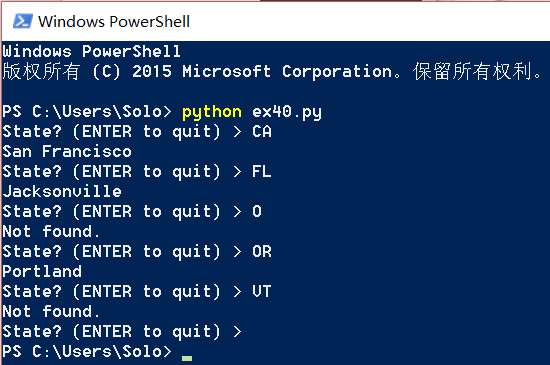《笨办法学Python》 第40课手记
《笨办法学Python》 第40课手记
本节课讲述的字典,一种比数组更强大的数据结构,字典(dict)的另一个名称是散列(hash)。
我将在后面具体解释dict,首先通过作者的代码来了解一下dict。
原代码如下:
cities = {'CA': 'San Francisco', 'MI': 'Detroit',
'FL': 'Jacksonville'}
cities['NY'] = 'New York'
cities['OR'] = 'Portland'
def find_city(themap, state):
if state in themap:
return themap[state]
else:
return "Not found."
# ok pay attention!
cities['_find'] = find_city
while True:
print "State? (ENTER to quit)",
state = raw_input("> ")
if not state: break
# this line is the most important ever! Study!
city_found = cities['_find'](cities, state)
print city_foundwhile true创建了一个永远执行的while循环,这是惯常的做法。
cities[‘_find’] = find_city这里的cities[‘_find’](是创建的字典中的一个元素)被赋值成find__city函数,也可以理解为cities[‘_find’]是一个函数变量。
结果如下:
本节课涉及的知识
Python中的字典:
Python种的字典由键(key)和值(value)组成。键(key)相当于我们日常生活中字典的页码,是一种索引或者说地址,每一个键都对应一个值。键和值实际组成了一个散列函数。
下表是字典的常用操作:
| Operation | Result |
|---|---|
| len(a) | the number of items in a 得到字典中元素的个数 |
| a[k] | the item of a with key k 取得键K所对应的值 |
| a[k] = v | set a[k] to v 设定键k所对应的值成为v |
| del a[k] | remove a[k] from a 从字典中删除键为k的元素 |
| a.clear() | remove all items from a 清空整个字典 |
| a.copy() | a (shallow) copy of a 得到字典副本 |
| k in a | True if a has a key k, else False 字典中存在键k则为返回True,没有则返回False |
| k not in a | Equivalent to not k in a 字典中不存在键k则为返回true,反之返回False |
| a.has_key(k) | Equivalent to k in a, use that form in new code 等价于k in a |
| a.items() | a copy of a’s list of (key, value) pairs 得到一个键值的list |
| a.keys() | a copy of a’s list of keys 得到键的list |
| a.update([b]) | updates (and overwrites) key/value pairs from b 从b字典中更新a字典,如果键相同则更新,a中不存在则追加 |
| a.fromkeys(seq[, value]) | Creates a new dictionary with keys from seq and values set to value 创建一个新的字典,键来自seq,值对应键对应的值 |
| a.values() | a copy of a’s list of values 得到字典值的副本 |
| a.get(k[, x]) | a[k] if k in a, else x 得到a[k],若存在返回x |
| a.setdefault(k[, x]) | a[k] if k in a, else x (also setting it) 得到a[k],若不存在返回x,并设定为x |
| a.pop(k[, x]) | a[k] if k in a, else x (and remove k) 弹出a[k],若不存在则返回x,同时将删除k键 |
| a.popitem() | remove and return an arbitrary (key, value) pair 弹出a中对象的键和值,并删除弹出的键和值 |
| a.iteritems() | return an iterator over (key, value) pairs 返回a中所有对象(键和值) |
| a.iterkeys() | return an iterator over the mapping’s keys 返回a中所有键(索引) |
| a.itervalues() | return an iterator over the mapping’s values 返回a中所有值 |





